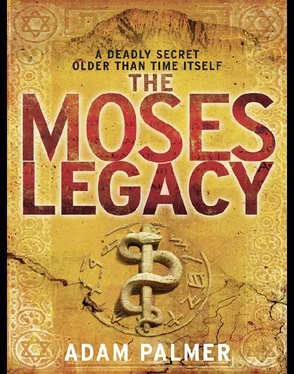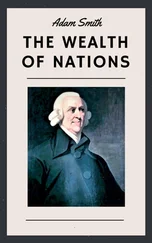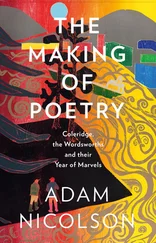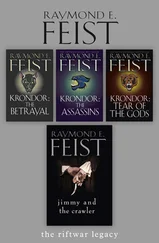Adam Palmer - The Moses Legacy
Здесь есть возможность читать онлайн «Adam Palmer - The Moses Legacy» — ознакомительный отрывок электронной книги совершенно бесплатно, а после прочтения отрывка купить полную версию. В некоторых случаях можно слушать аудио, скачать через торрент в формате fb2 и присутствует краткое содержание. Жанр: Триллер, на английском языке. Описание произведения, (предисловие) а так же отзывы посетителей доступны на портале библиотеки ЛибКат.
- Название:The Moses Legacy
- Автор:
- Жанр:
- Год:неизвестен
- ISBN:нет данных
- Рейтинг книги:4 / 5. Голосов: 1
-
Избранное:Добавить в избранное
- Отзывы:
-
Ваша оценка:
- 80
- 1
- 2
- 3
- 4
- 5
The Moses Legacy: краткое содержание, описание и аннотация
Предлагаем к чтению аннотацию, описание, краткое содержание или предисловие (зависит от того, что написал сам автор книги «The Moses Legacy»). Если вы не нашли необходимую информацию о книге — напишите в комментариях, мы постараемся отыскать её.
The Moses Legacy — читать онлайн ознакомительный отрывок
Ниже представлен текст книги, разбитый по страницам. Система сохранения места последней прочитанной страницы, позволяет с удобством читать онлайн бесплатно книгу «The Moses Legacy», без необходимости каждый раз заново искать на чём Вы остановились. Поставьте закладку, и сможете в любой момент перейти на страницу, на которой закончили чтение.
Интервал:
Закладка:
Furthermore, as Vice Minister of Culture, he could stop either of them from working in Egypt again. This would have been more of a blow to Gabrielle than to Daniel, but it was Daniel who was the more conciliatory of the two.
‘That’s fine with me. I don’t even mind if my name goes last. I’m just thrilled and honoured to be part of this.’
Mansoor responded to Daniel’s pliant reply by offering him a consolation prize.
‘You do know of course that we have another long document in the ancient script.’
‘ What document?’ Gabrielle had asked, taken aback by this revelation.
‘Oh, just a papyrus that’s been lying around in the archives for some time. It was never really given much thought, but in the current light, I think it’s fair to say that it takes on a new importance.’
It was this other document that Mansoor was taking them to see now. He led them into a room full of metal shelves laden with boxes. He went over to a shelf and stood before a brown cardboard box with some Arabic writing on it in thick, black magic marker. Daniel understood the writing, but all it said was ‘Papyrus’ and ‘Clay jar’. Mansoor lifted the box and brought it over to a workbench. He deposited it carefully on one side, while Daniel and Gabrielle stood on the other. Then he opened the box, reached in and produced what looked like a wooden-framed glass box which he also deposited on the table.
Daniel stared at it in awe. What he was looking at, he realized, was a glass-mounted papyrus which contained about fifty lines of writing in Proto-Sinaitic script. Gazing now at the longest piece of text that he had ever seen in this ancient language almost brought tears to his eyes.
The writing was set out horizontally relative to the paper in a single column, running parallel to the shorter side of the papyrus and perpendicular to the longer side. In this respect it differed from, say, a Jewish Torah scroll written in a series of columns, to be unfurled horizontally and read one column at a time.
Daniel stared at it for a long time, taking in the fact that what he had before him was a very ancient papyrus in remarkably good condition. After a while, he looked up at Mansoor. ‘What is it?’ he asked.
Mansoor frowned. ‘That’s what you’re supposed to tell me.’
‘I mean what can you tell me about its provenance?’
‘First of all, can you translate it?’
Daniel sat down, took out his one-page concordance and started looking for words in the papyrus that matched. After some considerable time, he looked up, disappointed.
‘There aren’t enough words matching the concordance. I found nine instances of Jehovah and three variants of El which I assume is a generic reference to God. But there were no other common words.’
He noticed that Gabrielle looked disappointed. He could always tell her mood from her face, even when she tried to hide it. It was harder to tell with Mansoor; Daniel had not known him long enough.
‘But nine instances of Jehovah,’ said the Egyptian contemplatively. ‘What’s your general impression? I mean what sort of a document do you think it is?’
‘Well, my first impression was that it was a proclamation intended to be unfurled vertically and read out loud by a herald to an assembled audience. But then I rejected that because proclamations would more likely be engraved on a stone monument and displayed in public to be seen by one and all.’
‘Not if it were a proclamation to a nomadic people,’ Gabrielle interrupted, picking up the theme of the nomadic Shasu of Yahowa that they had talked about earlier.
Daniel nodded approvingly. ‘True. But then I considered the possibility that it might be a letter or missive to a single individual. I also noticed a peculiarity about the way it was set out: every single line is different in length. That is precisely the way that poetry would be written.’
‘So which is it?’ asked Mansoor. ‘A proclamation to a nomadic people or an ancient poem?’
‘Well, if it weren’t for the presence of the name Jehovah, one might speculate that this was copied or plagiarized from an old Egyptian poem. But Jehovah precludes that.’
‘So it must be a proclamation to the Israelites,’ said Gabrielle.
Daniel wanted to proceed more cautiously. He turned to Mansoor. ‘I’ve told you as much as I can based on looking at it. I might be able to tell you more if you can give me some idea about its origins.’
‘I can tell you that it’s been carbon dated to around 1600 BC,’ said Mansoor.
‘That makes it older than the Bible.’
‘Yes it does. But I can’t tell you when or where it was found.’
‘Why not?’
‘Because I don’t know. That is, I can tell you where it was found latterly. But I cannot tell you where it was found originally.’
‘What do you mean?’
‘It was found here in one of the storage rooms, when we were in the process of entering all the items in the museum on to our new computer database. But it didn’t have any object card with it, so the provenance is completely unknown. All we found was the clay jar with the papyrus.’
‘Clay jar?’
‘Yes, the papyrus was actually found inside an old clay jar. We only mounted it in glass recently, shortly after finding it. But we haven’t been able to trace the origins of either the papyrus or the jar.’
‘But aren’t they listed in the museum’s register?’
‘We did a thorough search of the register and haven’t found it.’
‘Isn’t that rather… strange?’
‘It’s not suspicious, if that’s what you mean. There are quite a few items in the storage rooms that we haven’t been able to find listed in the register books.’
‘When you say “the register books ”… I mean, aren’t the records computerized now?’
‘Actually, we’re still in the process of creating our computerized database of objects and artefacts – with the help of an American non-profit organization. But you have to understand that until 2006 the registration system was entirely manual. We’ve got a quarter of a million objects in this museum, only half of which are in the database. It was when this papyrus and its container were due to be entered into the system, that we discovered it was unlisted.’
‘But how could something like that happen?’ asked Daniel.
‘You have to understand,’ Mansoor continued sheepishly, ‘that due to historic reasons, the manual numbering system is a bit fragmented. We actually have four different numbering systems that developed over time. But unfortunately, different objects were categorized according to the different systems. In fact, some items have numbers in more than one of the numbering systems.’
‘But how could you track so many objects with such a fragmented system?’
‘We couldn’t. It was a real nightmare. And to make matters worse, we didn’t even have anyone specifically trained in archive maintenance. In practice, responsibility for keeping the records was divided between the sections. Each section had responsibility for its own objects and artefacts.’
‘Okay, may I see the clay jar?’
Mansoor put on a pair of latex gloves, reached into the box, pulled aside some padding and then produced the clay jar, carefully depositing it on the workbench in front of them. Daniel put on a similar pair of gloves and gently turned the jar this way and that to get a better look. The outside of the jar looked quite plain. Then a very faint trace of an engraving on the side caught Daniel’s eye.
‘Holy shit!’
‘What?’ asked Mansoor, picking up on Daniel’s excitement.
‘Take a look at that,’ said Daniel, handing the jar over to Mansoor.
The Egyptian held it up to the light and tilted it back and forth to get a better view. His face changed when he saw what Daniel had seen: a barely visible engraving of a serpent coiled around a pole.
Читать дальшеИнтервал:
Закладка:
Похожие книги на «The Moses Legacy»
Представляем Вашему вниманию похожие книги на «The Moses Legacy» списком для выбора. Мы отобрали схожую по названию и смыслу литературу в надежде предоставить читателям больше вариантов отыскать новые, интересные, ещё непрочитанные произведения.
Обсуждение, отзывы о книге «The Moses Legacy» и просто собственные мнения читателей. Оставьте ваши комментарии, напишите, что Вы думаете о произведении, его смысле или главных героях. Укажите что конкретно понравилось, а что нет, и почему Вы так считаете.












